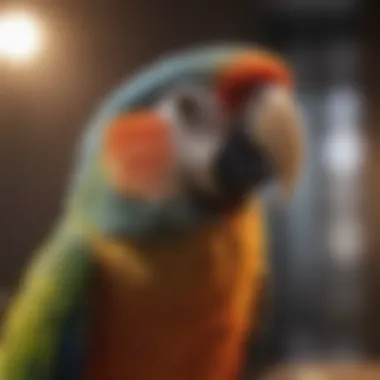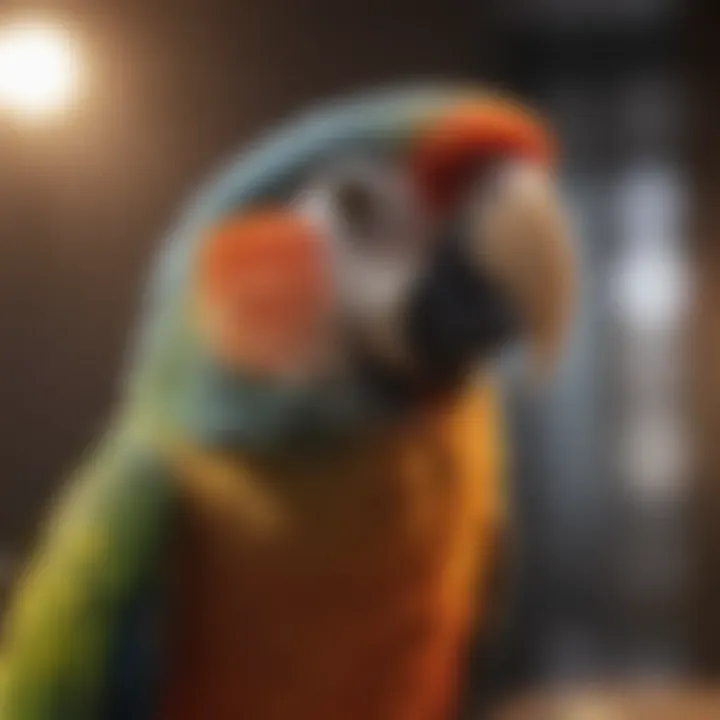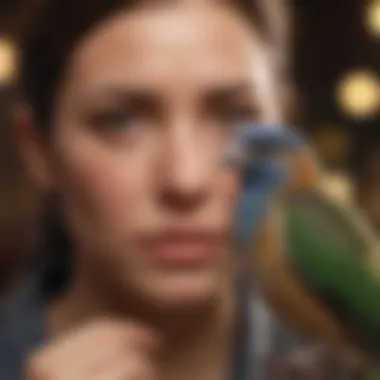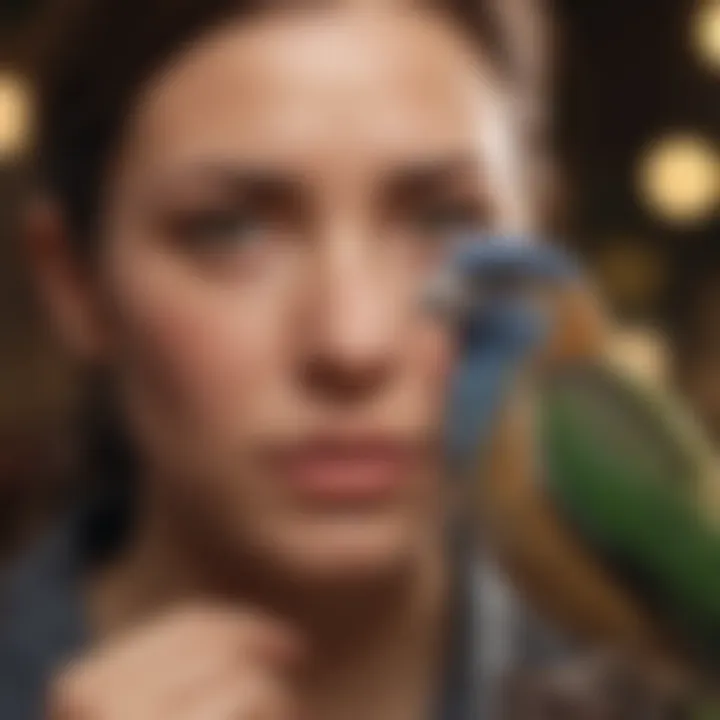Understanding Bird Behavior: Insights for Enthusiasts


Intro
Birds are complex creatures, each possessing their own personalities and quirks. For enthusiasts looking to bond deeply with their feathered companions, understanding bird behavior can offer invaluable insights. Whether you’re a new bird parent or a seasoned breeder, knowing what your pet is communicating through its actions is crucial in fostering a happy and healthy environment.
In this guide, we will explore fundamental and advanced topics related to bird behavior. From daily care routines to interpreting body language, each section is crafted to provide a comprehensive understanding. This knowledge not only enhances your relationship with your avian friend but also opens the door to a nurturing environment where they can flourish.
Let’s take a closer look at the essentials of caring for pet birds, revealing the key nuances of their behavior and needs.
Intro to Bird Behavior
Birds, whether fluttering around a backyard feeder or nestled in a cozy cage, display a complex language of behaviors that speaks volumes beyond mere chirps and flaps. Understanding bird behavior acts not only as a guide for pet owners, but it also deepens the bond between you and your feathered companion. Grasping the nuances of how birds interact, express themselves, and respond to their environments can significantly enhance their quality of life.
What defines bird behavior is multifaceted. It's intertwined with species instincts and learned responses developed through experiences. An enthusiastic pet owner can observe a parakeet's playful demeanor or a cockatoo's dramatic flair, noting how these traits can stem from natural habits or socialization. Recognizing these indicators helps owners better appreciate their pets’ needs, leading to improved care and a happy household.
What Defines Bird Behavior
Bird behavior encompasses various actions and reactions that characterize how birds live and interact. At its core, it combines instinctual timely responses as well as learned habits acquired over time.
Instinctual behaviors are often influenced by genetic coding; for example, certain finches possess innate strategies for foraging, while eagles display grooming techniques unique to their species. These instincts serve essential functions—whether that’s securing nourishment, establishing territory, or courting potential mates. Additionally, this type of behavior often helps in survival, as seen when a bird quickly retreats to safety upon sensing danger.
Learned behaviors, on the other hand, occur through interactions with their environment or other birds. Just consider the remarkable ability of parrots to mimic sounds or vocalizations they hear around them. This is not merely imitation but a sophisticated form of communication that indicates the bird's adaptability and intelligence. Birds like African Grey Parrots expertly navigate through social dynamics in their environment, showcasing how skillful they can be at imitating both sounds and behaviors.
Why Understanding Behavior Matters
Understanding bird behavior is crucial for several reasons. It allows enthusiasts to provide an environment tailored to meet their birds’ psychological and physical needs. For instance, recognizing when your canary is displaying signs of stress can prompt proactive measures to enhance its comfort. This knowledge can also guide bird owners in selecting suitable play and enrichment activities that resonate well with their pets.
Knowing how birds communicate can lead to more empowered pet ownership. When an owner understands vocalizations, they can better meet their birds’ emotional needs. For example, recognizing an alarm call from your cockatiel can help you identify potential dangers in the household—be it a sudden loud noise or a stray cat wandering too close.
Moreover, educating oneself about bird behavior is instrumental in developing patience and empathy. It’s not just about engaging with the surface level of pets; it’s about comprehending the underlying sentiments that drive their actions. By observing and adapting to your bird’s behavioral cues, you can create a nurturing environment that fosters trust and companionship.
"To care for any creature enough to make it a companion is to open oneself to grief, yet also to have the capacity for love like no other."
This understanding not only enhances the bond between bird and owner but also enriches the overall experience of birdkeeping. Whether you’re nurturing a rescue or raising a chick, being attuned to your bird’s behavior is invaluable.
Types of Bird Behaviors
Understanding the types of bird behaviors is essential for any enthusiast keen on forming a deeper bond with their feathered friends. Bird behavior can be classified mainly into instinctual and learned behaviors. These categorizations frame the foundation of how birds interact with their environment, make decisions, and respond to various stimuli. By grasping these types of behaviors, bird owners can foster environments that align with their pets' natural inclinations while also encouraging healthy growth and development.
Instinctual Behaviors
Instinctual behaviors are the hardwired actions that birds exhibit, arising from their evolutionary heritage. These behaviors are crucial for survival and reproduction, influencing how birds feed, nest, and socialize.
Feeding behaviors
Feeding behaviors primarily revolve around the basic need for sustenance. They manifest in various ways, such as foraging techniques and preferences for specific types of food. Notably, birds have evolved different feeding styles to adapt to the availability of food in their environments. For instance, some birds might be adept at cracking seeds, while others are skilled at catching insects mid-flight.
One key characteristic of feeding behaviors is their adaptiveness. Birds don’t just stick to one feeding method; they are often quite flexible, adjusting their habits based on seasonal changes or the introduction of new food types. This adaptability is a significant benefit for pet bird owners. By enriching their diets with varied foods, owners can mimic their birds' natural feeding behaviors, promoting better health and mental stimulation.
However, it’s essential to be careful with what you offer. Certain human foods can be harmful to birds, emphasizing the need for research and understanding before making dietary changes.
Nesting instincts
Nesting instincts are another core type of instinctual behavior, fundamental for reproduction and the continuation of species. For many bird species, successful nesting means secure locations where they can raise their young. Birds often have specific requirements for nesting materials and locations, which vary greatly across species. A parakeet, for instance, might prefer soft, fibrous materials to make its nest, while a finch is likely to be more selective about its nest site and structure.
The unique feature of nesting instincts lies in their complexity. Not only do these instincts dictate where and how birds nest, but they also include behaviors like egg laying and brood care. This characteristic is beneficial for bird owners to recognize, as providing an appropriate nesting environment can significantly affect their birds’ stress levels and overall well-being. On the downside, if these instincts aren't properly accommodated, it could lead to anxiety for the birds.
Flocking tendencies
Flocking tendencies are another fascinating aspect of instinctual behavior. Many bird species naturally prefer to live in groups, which can provide safety in numbers against predators. Observing how birds interact within these flocks offers keen insights into their social dynamics. For instance, some species exhibit complex flock formations during flight, demonstrating not just instinct but also a level of teamwork and communication that is captivating.
The demerit of isolation can weigh heavily on those species. Birds that thrive in high social environments may experience stress if kept alone for prolonged periods. As such, pet owners must consider adding companions or engage extensively with their birds to satisfy this need for socialization. A solitary life could lead to behavioral issues over time.
Learned Behaviors
Learned behaviors reflect a bird's ability to adapt through experiences. Unlike instinctual behaviors, these skills can change based on the bird's interactions with its environment, companions, and owners.
Imitation of vocalizations
Imitation is a remarkable skill among many bird species, especially those like parrots which excel in mimicking human speech. This unique aspect of learned behavior plays a significant role in social bonding. Birds that pick up on and adapt vocalizations can express their needs more effectively, enhancing communication with their human companions.
Imitating sounds around them not only keeps birds mentally stimulated but also helps them feel included in their social group. However, it's worth noting that birds who are not constantly interacted with may not mimic well, highlighting the need for consistent engagement between the pet and its owner.
Problem-solving skills
Problem-solving skills in birds have been a captivating area for researchers. Birds, particularly corvids, show remarkable aptitude in using tools and devising strategies for food retrieval. This characteristic not only showcases their intelligence but also emphasizes the cognitive engagement birds can have within their environment.
By providing enrichment activities, such as puzzles or new challenges, owners can observe their birds' problem-solving skills evolving. Nonetheless, if such cognitive challenges are not presented, birds might become bored and develop monotonous behaviors which can lead to stress and even health issues.
Social interactions


Social interactions among birds heavily influence their behavior, demonstrating the importance of social structures. Many birds communicate, groom, and engage in playful activities, reinforcing their bonds. Such interactions are not merely instinctual but learned over time based on experiences within their flock.
These social dynamics underline why it’s crucial for pet owners to ensure their birds have avenues to socialize, whether with other birds or through interactions with humans. Lack of social opportunities can lead to withdrawal, aggression, or other distress signals, pushing the need for owners to strive for a balance in their pets' social and environmental needs.
The exploration of these various behaviors provides a rich tapestry of understanding, enabling bird owners to foster a nurturing environment conducive to the health and happiness of their avian companions.
Social Structures Among Birds
Understanding social structures is crucial for anyone looking to deepen their knowledge about bird behavior. Birds are not solitary creatures; rather, their behaviors are significantly influenced by their interactions with others. From the way they establish hierarchies to how they form bonds, recognizing these social dynamics can help pet owners foster better relationships with their feathered companions. Social structures also greatly affect stress levels, mating, and the overall health of birds.
Hierarchy and Pecking Order
Hierarchy plays a pivotal role in how birds function within their communities. Each bird tends to have a specific rank, influencing access to resources such as food and nesting sites. The pecking order can seem brutal at times, with more dominant individuals asserting their power through actions like posturing or even brief displays of aggression. However, this behavior serves to maintain order among the flock, ensuring everyone knows their place.
It's important to be aware of these dynamics as they can lead to stress or conflicts in captivity. For instance, when introducing new birds into an existing space, understanding the pecking order is key to preventing aggressive interactions. Here are some key points about hierarchy in birds:
- Resource allocation: Dominant birds often claim access to food and breeding areas, impacting the health of subordinates.
- Social balance: A well-established pecking order can provide stability, reducing unnecessary conflicts.
- Stress reduction: Recognizing one’s place in a hierarchy can alleviate anxiety among birds.
Bonding and Pairing Behaviors
Bonding behaviors among birds are fascinating and essential for their overall well-being. These connections aren't just for mating; they encompass friendships, parental roles, and social alliances.
Mate selection
When birds choose their mates, it isn't just a random affair. Each species often has specific characteristics that they look for, which can include plumage quality, skillful displays, and even the ability to find food. Selecting a mate is a significant aspect of ensuring the survival of the species, as stronger couples tend to produce healthier offspring.
- The process is often based on visual signals, where the most vibrant or unusual feathers attract potential mates.
- Such preferences ensure that the genetic diversity remains robust in a population. However, being overly reliant on aesthetic traits can sometimes lead to problems if environmental conditions change.
Courtship displays
Courtship displays serve as a fascinating way for birds to communicate their readiness to mate. Males typically engage in elaborate rituals, which can involve singing, dancing, or even offering gifts like food. These displays are not just for show; they are crucial for demonstrating fitness and genetic health.
- For instance, a male might perform an intricate dance, showcasing strength and agility.
- It is essential for reinforcing the bond between partners. However, if the displays are too demanding, they might exhaust the bird, raising questions about their effectiveness in every environment.
Parental care
Parenting in birds is often a cooperative affair, particularly in species that mate for life. Both partners may share the responsibilities of incubating eggs and feeding chicks, enhancing the survival rate of the nestlings. Parental care is especially critical in the early stages of life.
- Diverse methods: Different species exhibit various methods of nurturing, impacting the learning experiences of the young.
- While dual parenting often results in healthier offspring, it can also lead to competition between parents over who is doing more, potentially causing stress in their relationships.
Understanding these aspects of bonding and pairing behaviors not only enriches our perspective but also aids in creating an environment that understands and meets the emotional and social needs of pet birds. Recognizing the dynamics at play can foster a deeper and more harmonious bond with them.
Environmental Influences on Behavior
Understanding how the environment shapes bird behavior is crucial for anyone interested in these fascinating creatures. The behaviors of birds can be significantly affected by the conditions in which they live, ranging from their natural habitats to the spaces humans create for them. This section aims to unpack these influences, offering insights into how habitat and environmental enrichment play vital roles in shaping avian behavior.
Impact of Habitat
Natural settings versus captivity
The distinction between natural settings and captivity profoundly impacts bird behaviors. In their natural habitats, birds have a plethora of stimuli—various food sources, natural perches, and companions—that drive them to exhibit their full behavioral spectrum. The key characteristic of natural settings is the complexity they offer. Birds in the wild navigate through trees, bushes, and open skies, using their instincts for foraging and socializing. This richness fosters not only physical activity but also mental stimulation, essential for their overall well-being.
When it comes to captivity, however, things can get tricky. While many birds do adapt successfully to indoor environments, it often lacks the diversity found in the wild. Captive birds may display limited foraging behaviors since most of their food is pre-prepared and easily accessible. The unique feature of captivity is that while it can provide safety and security, it can also stunt their natural instincts, leading to behaviors like boredom or stress.
- Advantages of Natural Settings:
- Disadvantages of Captivity:
- Diverse stimulation promotes behavioral development.
- Birds learn needed survival skills.
- Limited foraging reduces cognitive engagement.
- Potential for stress in restricted environments.
Territorial behaviors
Territorial behaviors are another aspect shaped by environmental influences. In the wild, birds establish and defend territories crucial for nesting, feeding, and mating. This behavior reflects a key characteristic: the need to protect resources from competing birds. When birds establish a territory, they engage in vocalizations and displays to ward off intruders, deciding who gets access to certain areas.
This behavior has significant implications for bird owners. Captive birds may feel the urge to establish their territory within their cages or homes, particularly if more than one bird is present. The unique feature of territoriality is that it can lead to stress or aggressive behaviors, especially if environment does not allow for separate spaces.
- Advantages of Territorial Behaviors:
- Disadvantages:
- Encourages natural instincts in controlled areas.
- Helps maintain social hierarchies among birds.
- Can lead to aggressive interactions in captivity.
- Stress levels may increase without adequate space.
Role of Enrichment
Toys and Social Interaction
The role of enrichment in the lives of captive birds can’t be overstated. Enables essential stimulation that should mimic some aspects of their natural environments. The key characteristic of using toys is the chance they provide for exploration and interaction, vital components for both mental and physical health. Toys that mimic natural elements, such as wooden blocks, ropes, or swings, can engage birds in activities similar to those they would perform in the wild, making their environment feel less monotonous.
Additionally, social interactions with humans or other birds serve as a unique feature of enrichment. Having another bird can alleviate loneliness and encourage playful behaviors similar to those found in flocks.
- Advantages of Toys:
- Disadvantages:


- Stimulate natural behaviors and instincts.
- Offer mental exercise and reduce boredom.
- Not all toys will engage every individual bird.
- Overwhelming the habitat with too many toys can cause stress.
Environmental changes
Changes in the environment can also significantly affect bird behavior. Regularly altering the arrangement of their space, introducing new objects, or changing the setting allows birds to explore and adapt, reflecting a vital aspect of their natural instincts. This points to the key characteristic of variability in their surroundings, which can keep a bird's mind sharp and responsive.
Moreover, environmental changes act as a unique feature to reduce stress; the novelty factor can invigorate a bird's curiosity and eagerness to explore. However, too frequent or drastic changes may lead to anxiety.
- Advantages of Environmental Changes:
- Disadvantages:
- Prevents stagnation and promotes adaptability.
- Sparks problem-solving behavior, beneficial for cognitive health.
- Some birds may prefer routine and can feel anxious with sudden changes.
- Must balance stimulation without overwhelming the bird.
Understanding the role of environment in bird behavior offers great opportunities for enhancing the relationship between birds and their caregivers. Creating an engaging and supportive space enables birds to thrive and express their natural instincts while in human care.
Communication in Birds
The world of bird communication is a rich tapestry woven with intricate vocalizations and expressive body language. For pet bird owners and enthusiasts, understanding how birds convey messages provides a deeper appreciation for their behavior. Communication is not just about the noise they make or the positions they assume; it’s a crucial part of their social interactions and overall well-being. When we grasp the nuances of how birds communicate, we empower ourselves to foster a more supportive environment for our feathered companions.
Vocalizations and Calls
Vocalizations and calls are the most apparent means of communication for birds. They use sound to express a myriad of emotions, alert others to danger, or attract mates. Observing and interpreting these vocalizations can lead to enhanced interaction and bonding between bird owners and their pets.
Alarm calls
Alarm calls serve as an important aspect of bird communication, acting as a warning signal to alert others of potential threats. This specific call is often characterized by sharp, high-pitched sounds that pierce through the quiet of the environment. Its primary function is to signify danger, allowing other birds to react quickly, which contributes to survival. In the scope of this article, recognizing alarm calls is beneficial as it highlights an essential survival mechanism that both wild and pet birds retain. A unique feature of alarm calls is their varied intensity and urgency, which can indicate the level of threat. A downside might be the stress sound may cause to captive birds by overreacting to their surroundings, thus necessitating a careful approach to their environment.
Mating calls
Mating calls are another fascinating component of avian vocalization, crucial for attracting partners during the breeding season. Mating calls can vary significantly between species, often marked by melodious tunes designed to showcase one's fitness and desirability. This aspect of communication is beneficial as it not only assists in reproduction but also reflects the health and vitality of the bird. A unique feature of mating calls is their seasonal variance; they may become more frequent and elaborate during breeding periods. However, the downside is that stress or overcrowding can disrupt these calls, impacting natural processes.
Expressing needs and desires
Birds communicate their needs and desires through specific vocalizations that signal hunger, discomfort, or the need for companionship. These calls are often softer and more varied, indicating a range of feelings, making them essential for managing a bird’s well-being. For bird owners, learning to interpret these vocal cues lays the foundation for a responsive and nurturing relationship. The unique feature here is the adaptability of these calls, which can change based on the bird’s experiences and environment. However, relying solely on vocalizations can sometimes lead to misunderstandings, particularly if the owner misses subtle cues, highlighting the importance of comprehensive understanding.
Body Language
Body language complements vocalizations and offers a broader understanding of a bird’s emotional state. By observing these non-verbal cues, owners can better respond to their pet's needs and foster a nurturing relationship.
Wing positioning
Wing positioning can reveal a bird's mood. Extended wings can mean aggression or excitement, while tucked wings may indicate calmness or trust. This characteristic makes it a critical choice for understanding bird behavior. A unique feature of wing positions is their immediate visual impact, allowing owners to react quickly to a bird's emotional shifts. However, misinterpretation can occur; a bird might tuck its wings due to feeling vulnerable, which could be mistaken for relaxation, emphasizing the need for context.
Feather ruffling
Feather ruffling often indicates various emotional responses, from relaxation to preening behaviors. Ruffled feathers can signal that a bird is distress, thereby alerting an owner to address their needs. This aspect is crucial as it forms part of both the bird’s comfort and communication strategies. A unique feature of feather ruffling is how it can vary in intensity and context; a slight ruffle might signify contentment, while a full-fluffed display may indicate fright. Oversensitivity to feather ruffling could potentially lead to unnecessary anxiety for both the owner and the bird, pointing to the balance necessary in reading these cues.
Head movements
Head movements are subtle yet telltale signs of a bird's feelings and intentions. Nodding, tilting, or darting their heads can indicate curiosity, aggression, or submission, contributing to the overall context of bird communication. This behavioral aspect is practical, giving quick insight into a bird's mental state. A unique feature of head movements is their tandem with other behaviors; for instance, a bird tilting its head while vocalizing can show interest or inquiry. However, over-analyzing head movements might lead to misjudgment in situations where the bird's behavior is context-dependent, reinforcing a need for a holistic approach to understanding their signals.
By recognizing and interpreting both vocalizations and body language, bird owners can tap into the intricate world of avian communication, enhancing their bond with these remarkable creatures.
Behavioral Signs of Stress and Distress
Understanding stress indicators in birds is not just an academic exercise; it has practical implications for ensuring the well-being of our feathered friends. Pet owners who can recognize signs of anxiety or discomfort can intervene before issues escalate. Birds, unlike cats or dogs, may mask their distress until it becomes severe. So, paying attention to subtle changes in behavior is crucial for their health and happiness. Here, we will discuss the elements of stress indicators and how they inform better pet care practices.
Recognizing Stress Indicators
Birds often communicate their feelings through behavior. The following key signs may indicate that a bird is stressed:
Changes in vocalization
Vocalization is a primary method of communication for birds. A sudden shift in their usual calls can signal stress. For instance, if a bird that usually sings sweetly begins to emit harsh or erratic sounds, it could indicate discomfort or fear. Catching these vocal changes early can help owners pinpoint potential environmental stressors, such as loud noises or new pets in the home.
A unique aspect of vocalization is its individual nature. Each bird has a distinctive sound that reflects its personality; hence, the importance of knowing what ‘normal’ sounds like is paramount. Recognizing these changes can be a beneficial anchor for understanding their emotional state.
Feather plucking
Feather plucking is a concerning behavior often linked to stress, boredom, or even medical issues. When birds engage in feather plucking, it usually signifies that they are not in a suitable environment or that they are experiencing emotional stress. This behavior can lead to skin infections and further physical complications, thus emphasizing its seriousness.
Regarding the uniqueness of feather plucking, it can manifest differently among various bird species. Parrots, for example, may exhibit this behavior more frequently. Understanding why a bird might be plucking its feathers can lead to interventions that effectively address the underlying cause, thus benefiting the bird's quality of life.
Aggression or withdrawal
Aggression can manifest as biting or lunging, while withdrawal may look like a bird hiding or sitting listlessly. Both behaviors indicate a level of unease, peaking when the bird feels threatened or overwhelmed. When owners witness these behaviors, it raises a red flag that something in their environment needs attention.


The peculiar feature of aggression or withdrawal is that these behaviors can often be addressed through modifications in care. For instance, minimizing sudden loud noises or offering more safe spaces for retreat can impact overall happiness. Recognizing these signs early allows for the opportunity to foster a more nurturing environment that supports the bird's needs.
Mitigating Stress in Birds
It is vital to know how to help a stressed bird. Once signs of distress are identified, the next step is to create a more accommodating space. Here are some strategies:
Creating a safe environment
A safe environment isn’t just about a cozy cage; it’s about ensuring the entire area around them feels secure. This includes considering factors like placement away from heavy foot traffic or windows that may expose them to outside dangers. Furthermore, a bird that feels safe is more likely to exhibit normal behavior and vocalization.
One of the key characteristics of a safe environment is the presence of perches, toys, and places to hide. Birds thrive in environments that offer enrichment, as it occupies their time and fulfills their natural instincts. However, overloading their space with too many items can become a source of stress. Finding the balance is crucial for creating an enriching yet calming space.
Routine and predictability
Routine helps birds understand their day. Birds will feel secure knowing what to expect, leading to less anxiety. This may include having a consistent feed schedule or regular times for play and social interaction. For birds, predictability in their daily lives tends to reduce stress levels significantly.
The unique feature of routine is its power in establishing trust. Birds that can count on their owners for regular care are generally less stressed and more interactive. On the flip side, introducing erratic schedules can lead to agitation, as they might not know when to expect their next meal or social interaction.
In summary, by recognizing stress indicators and developing strategies to mitigate them, bird owners can dramatically improve their pet's quality of life. With every tweak in routine or adjustment in environment, we move closer to offering the optimal surroundings that our feathered companions deserve.
Cognitive Abilities of Birds
Understanding cognitive abilities in birds allows owners to appreciate these creatures beyond their beauty and cheerful sounds. Birds often demonstrate remarkable problem-solving skills and memory that are not only fascinating but also vital in providing suitable environments for them. Recognizing the intelligence of birds can greatly enhance a bird owner's experience, fostering a deeper bond and encouraging healthier social dynamics.
Problem-Solving Skills
Use of Tools
Many birds exhibit a notable capability to utilize tools in their daily activities. For instance, the New Caledonian crow has garnered attention for its ability to fashion sticks into effective foraging implements. This behavior is particularly fascinating since it shows an understanding of cause and effect. The crow does not merely pick up a stick; it can modify its shape to suit specific tasks. Such use of tools exemplifies the advanced cognitive skills of birds. By recognizing that certain tools can achieve desirable outcomes, bird owners can appreciate how their pets think and adapt their behavior to solve problems.
One key characteristic of this ability is its adaptability. Birds can learn to use various items creatively, making the tool use not just an isolated skill but part of a wider-thinking pattern.
Considerations: While it is generally a beneficial attribute for birds, this ability can sometimes lead to unintended consequences. For example, if a bird learns to use tools to gain access to prohibited areas, it may lead to mishaps in the household.
Navigation Strategies
Birds are also remarkable navigators. Their skills are particularly evident during seasonal migrations, where thousands of miles are crossed with precision. What scientists have found is that birds use a combination of visual cues, magnetic fields, and even celestial navigation to find their way.
This intricate navigation system highlights an impressive facet of avian intelligence. Birds that navigate accurately showcase not just instinct, but a mental map that is likely developed through experiences and memory retention of specific landmarks or environmental cues.
A unique feature of navigation strategies is how social species, like starlings, coordinate their movements in flocks, effectively using collective knowledge to improve their navigation. This is especially beneficial in avoiding predators and finding food sources. However, the downside is the potential for reliance on others, impacting individual learning.
Memory and Learning
Spatial Memory
Spatial memory is another critical cognitive ability in birds. It enables them to remember the locations of food caches or nest sites. Studies show that species like Clark's nutcracker can remember the locations of thousands of seeds hidden across vast landscapes, retrieving them months later. This characteristic reinforces the significance of memory in survival—an excellent reason for bird owners to ensure their pets have a stimulating environment.
Moreover, birds demonstrate a remarkable capacity to remember places where they found food before, which influences how they forage in the future. However, there can be a downside if spatial memory is not nurtured through varied and enriching environments; birds may struggle to adapt when changes occur.
Social Learning
Lastly, social learning adds another layer of cognitive complexity. Birds can learn new behaviors by observing others—a skill that is particularly evident in species like parrots that mimic sounds. New learners adapt their behaviors based on social interactions, shaping their skills continually as they grow.
This ability showcases the importance of social dynamics in bird communities and emphasizes how critical it is for owners to engage their birds socially. A rich social context can lead to substantial improvements in learning and behavior modification in pet birds. Conversely, a lack of social engagement can stunt this learning, underscoring the need for companionship, whether human or avian.
Culmination and Implications for Bird Owners
Understanding bird behavior is not just a matter of curiosity; it's a fundamental aspect of being a responsible and compassionate bird owner. The relationship between a bird owner and their feathered companion can flourish when there's a solid grasp of how birds think and act. By tuning into these behaviors, owners can create a living environment that is both stimulating and comforting for their pets.
One key benefit of comprehending bird behavior is improved communication. Just like in any relationship, effective communication lays the groundwork for coexistence. When you can interpret your bird's vocalizations and body language accurately, it fosters trust and strengthens your bond. This mutual understanding enables owners to address their birds' needs more effectively, whether it's environmental adjustments or socialization opportunities.
Moreover, acknowledging the cognitive abilities of birds allows owners to engage them in more meaningful activities. Many pet birds thrive on problem-solving tasks or interactive play. Owners who offer appropriate enrichment can see a notable increase in their pet's happiness and well-being, which is ultimately the goal for any responsible bird lover.
"A happy bird is a well-understood bird."
Considerations also arise when we delve into the implications of behavior in avian health. Stress, often rooted in environmental factors or lack of stimulation, can manifest through various indications. By staying attuned to these signals, bird owners can take proactive measures to reduce anxiety and promote a more fulfilling life for their pets. In short, understanding bird behavior equips owners with the tools to ensure their companions lead enriched lives.
Enhancing Relationships through Understanding
The secret to a great companion relationship lies in the understanding of one another. In the case of bird ownership, this understanding takes on a unique flavor. Birds possess a complex array of behaviors, and each interaction can add depth to your bond. By recognizing their subtle cues and vocalizations, you not only learn what they need but also appreciate their individuality. It’s not just about knowing that a squawk means something; it’s about interpreting that squawk in context.
Here are several ways to deepen this relationship:
- Observational Learning: Spend time watching your bird's actions. Take notes of what they favor, be it certain toys or activities. This knowledge will help tailor your interactions, ensuring they feel valued.
- Consistent Routine: Establishing a predictable schedule can create a sense of security for your bird. Regular feeding, playtime, and interaction can normalize behavior patterns, reducing anxiety.
- Engaging Play: Use toys that require clever engagement, such as puzzle feeders. This can work wonders for establishing trust and encouraging your bird to learn alongside you.
Understanding your bird is akin to learning a new language; patience pays off in strides, leading to enriching friendships.
Future Directions in Avian Behavior Research
The field of avian behavior research is continually evolving, bringing fresh insights into the world of our feathered friends. Presently, studies are expanding into domains such as social dynamics, cognitive flexibility, and even the environmental influences impacting avian behavior. With technology, researchers can monitor wild populations, using tracking devices to analyze how habitat changes can affect social structures and migration patterns.
Additionally, the inclusion of advanced behavioral metrics allows for a nuanced understanding of stress behaviors. As researchers delve deeper into this area, better methods for stress mitigation will undoubtedly emerge, benefiting both wild and domesticated birds alike.
Looking ahead, the implications for bird owners are vast. With emerging findings in this field, owners will gain access to practical strategies and insights, molding their approach to the care and management of their birds. Consider the possibilities of specialized training based on the latest research or preventive care that incorporates findings about stress and anxiety.
In essence, bird behavior research holds a promising future that could transform the way we understand and care for our avian companions, enriching their lives and ours.















